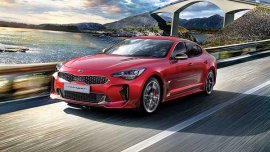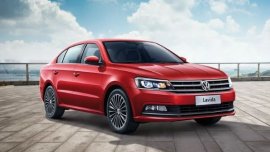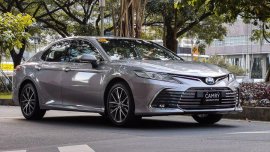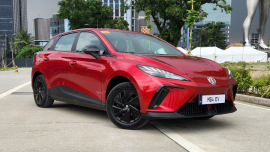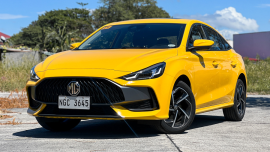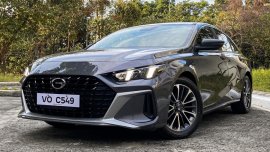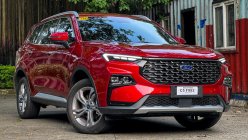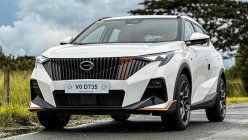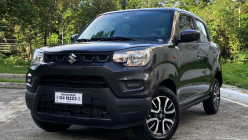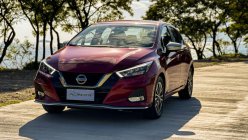In this review...
- Overview
- Exterior
- Interior
- Accessories
- Power & fuel consumption
- On-road performance & acceleration
- Handling & braking
- Verdict
1. Honda Civic 2017 review Philippines: Reborn

It was a modder’s dream car, a fringe benefit to its reputation for efficiency and reliability
Honda’s tagline for the tenth-generation Civic is a simple encapsulation of how they see their most recognizable model, and hopefully, how the market will see it, too. Featuring more aggressive lines, an even sportier streak than before, and bristling improvements under the hood, the new Civic arguably marks a return to form of a model range that had seemingly gone astray in its previous incarnations.
Pinoy drivers fell in love with the fifth-generation subcompact Civic (in both sedan and hatchback configurations) and all the tuning possibilities it brought: body kits, air intakes, aftermarket suspension, sway bars, even engine swaps and upgrades. Extra gauges such as for oil, battery and turbo boost pressure gauges felt right at home in the cockpit, along with racing seats and roll cages. It was a modder’s dream car, a fringe benefit to its reputation for efficiency and reliability. In a nod to these intrepid efforts, Honda released the VTEC-equipped Civic SiR.
The seventh-generation Civic assumed an even more family-oriented role with further improvements in terms of interior space; a flat rear floor freed up more second row legroom and was responsible for taking the Civic up to the compact car segment, giving birth to the “It’s Big, It’s Beautiful” advertising slogan at the time of its launch. It also was the first to introduce Honda’s DOHC K-series engines, doing away with conventional distributor-based timing in favor of an ECU-controlled timing setup. The eighth generation featured a significant redesign, with VTEC engines across three trim levels (1.8V, 1.8S and the 2.0S) and reportedly outselling the Toyota Altis, its closest rival at the time. Continuing subtle performance enhancements along with Honda’s Eco Assist technology, the ninth iteration of the Civic added increased fuel efficiency to its selling point.
2. Honda Civic 2017 review Philippines: Radically new exterior design

The front fascia now looks more razor-sharp, with a redesigned grille terminating seamlessly both ways into slit-shaped headlights composed entirely of an array of LEDs
To say that the tenth-generation Civic builds on all of these is an understatement; the model is underpinned by a new global platform, and features a radically new design that exudes an athleticism never before seen in the model’s history. One could not be faulted for being brazen enough to draw parallelisms between the new Civic and the current Ford Mustang, the fastback silhouette threatening to pounce on the pavement even at first glance. The front fascia now looks more razor-sharp, with a redesigned grille terminating seamlessly both ways into slit-shaped headlights composed entirely of an array of LEDs that shine like a prized crown jewel at Sotheby’s.
The chiseled hood lends an air of masculinity to the front view, with raised sides complementing the curves of the front fenders. An angular cut dominates the bottom part on both side doors, giving the new Civic’s profile a svelte appearance, while a power line runs through the door handles and to the rear, ending in C-shaped taillights that leave quite an impression as they whiz by you at speed, almost as if daring you to catch up with them. All of these can be found on the base 1.8E variant, distinguishable by a chrome grille; the subject of our discussion, the 1.5 RS Turbo, however, features a more serious piano black color surrounding the H badge, further upping the ante with its own RS rear wing spoiler and 17” RS design alloys.
>>> Related: Honda Civic for sale at affordable prices on Philkotse
3. Honda Civic 2017 review Philippines: Typical Hona interior
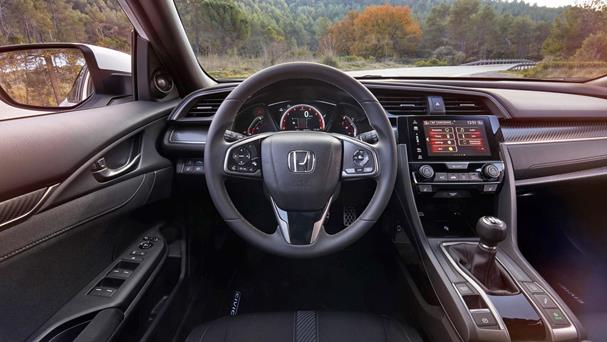
The full-color TFT instrument cluster is bright enough and easy to read even in daytime conditions
Interior is typical Honda: plush, purposeful and brimming with tech. No fake wood or pretentious faux carbon fiber trim to be found here, thank you very much. The full-color TFT instrument cluster is bright enough and easy to read even in daytime conditions, incorporating the standard speedometer, odometer, tachometer, fuel indicator and thermostat, with the addition of a turbo indicator.
Seating
Climbing into the driver’s seat was a bit of a challenge because of the lower height, but once inside I was able to settle in easily enough. The leather-wrapped steering wheel had just the right amount of thickness for my hands, and I could have sworn that I saw the H logo glisten mischievously, flanked as it was by the buttons on the wheel. As a matter of habit, I took out my wallet to place it on the door pocket, underneath the switches; it was a bit too narrow for my tastes, so I placed it on the center console instead.
Leather seats are standard, which exude a premium feel on this top-of-the-line variant and makes for easier cleaning. Front seats are supple without being too rigid, and cradle the body well, with the relatively high H-point compensating somewhat for the car’s lower stance; if that wasn’t enough, the driver’s seat features eight-way electric adjustment. Five 3-point ELR seatbelts fasten occupants firmly, a must for a car that promises power from the looks alone. Dual front and side plus curtain airbags on the RS Turbo complement Honda’s ACE body design, which is engineered to dissipate impact forces away from the cabin, for passive safety.
One gripe I do have with the interior is the rather large space the center console takes up, no doubt on account of the Earth Dreams CVT unit which is standard even on the Civic E variant. I noticed the same effect on the new Mitsubishi Montero Sport, where the 8-speed automatic transmission practically eats up space between the driver and front passenger, making for a rather cramped ride. Maybe it’s just me, but I wonder about the point of having sophisticated transmissions if they’re just going to cancel out efforts at increasing interior space.
Honda Civic 2017 Philippines: Cargo
Performance-oriented as it may be, the Civic RS Turbo still retains some family-friendly touches. ISOFix child anchors for one, and a rather cavernous 525-liter boot out back for swallowing up groceries or luggage. That trunk space is expandable to accommodate more substantial cargo, courtesy of the 60:40 split fold rear seats. The Honda Civic 2017 also features plentiful storage options via cup holders and the aforementioned center console (although folding down the center armrest to access the second row cup holders means one less passenger).
4. Honda Civic 2017 Philippines: Accessories
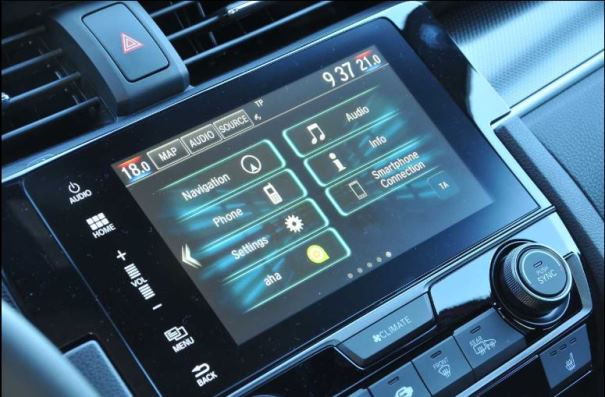
In-car entertainment and navigation duties are assumed by the new 7-inch touchscreen
In-car entertainment and navigation duties are assumed by the new 7-inch touchscreen display that sits at the center of the dashboard. Controls such as those for the dual-zone climate control and head unit interface are within easy reach of the driver. I‘ve yet to get accustomed to the electronic parking brake though, and the Econ button (used to control throttle, shift mapping and air conditioning to maximize fuel efficiency), might be better placed on the dashboard instead.
The tenth generation Civic retains nifty touches such as cruise control; a walk-away auto lock feature that engages the security system once you are more than 2 meters (6 feet) away from the car; an emergency stop signal (ESS) that flashes your brake lights to warn drivers at the rear when you are engaged in a panic braking situation; and a rear camera with guidelines that allow you to gauge the distance between the car’s rear and nearby objects using the in-dash screen, a must given the slightly low visibility offered by the rear window.
5. Honda Civic 2017 Philippines: Power & fuel consumption
Under the hood lies the ultimate weapon of the Civic RS Turbo’s intimidation: a Euro 4-compliant 1.5L Earth Dreams Technology DOHC VTEC powerplant, transmitting 170 HP and 220 Nm of torque on the ground via a Honda Earth Dreams Continuously Variable Transmission. The turbocharger itself is a single-scroll affair, utilizing 215 kPa of boost pressure and equipped with an internal wastegate. Honda markets the engine as having a fuel consumption of between 14 and 17 kilometers per liter, running on 91 RON unleaded at the pumps. But if you desire a more powerful base engine, the Subaru WRX 2017 fits the bill.
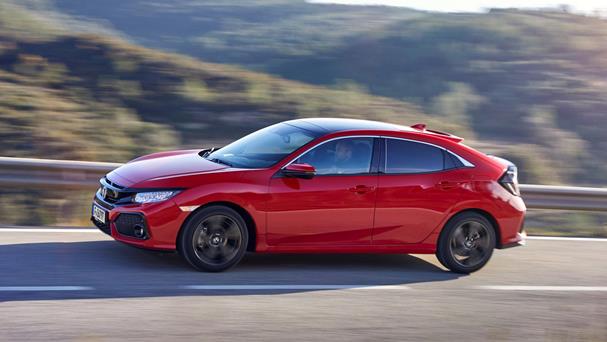
Performance-oriented as it may be, the Civic RS Turbo still retains some family-friendly touches
6. Honda Civic 2017 Philippines: On-road performance & acceleration
Once I had fully merged with traffic, it was time to sample the car’s power. Granted, I couldn’t take advantage of the full 127 horses underneath the hood (Metro Manila traffic, as usual), but I did find the engine responsive enough to my input, for something that uses drive-by-wire, anyway; my daily driver uses an electronic throttle too, so I’m familiar with that half-second or so of lag between stepping on the gas pedal and the engine responding accordingly. In this case, the Civic RS was sprightly, belying its dimensions and proportionally smaller powerplant. There was a noticeable effort during overtaking, but only slightly, as the CVT worked smoothly to match the ideal gear for the engine speed.
The electric power steering felt benign (as it typically does in other cars these days), but at least it didn’t make lane shifting and cornering a strenuous exercise; quite the opposite in fact. However, it does serve as an additional incentive for the driver to be alert behind the wheel. Engaging the transmission’s Sport mode, I found the paddle shifters engage easily at the flick of my fingertips, probably quicker than a similar setup I’ve used on another vehicle. The front MacPherson struts and rear independent multilink suspension soaked up road imperfections pretty well, even as I was consciously avoiding the worst ruts. Stopping power was stable enough even at speed, thanks to the Civic’s standard ABS with Electronic Brakeforce Distribution (EBD). NVH suppression is exceptional, despite the fact that I was zipping between trucks and jeepneys.
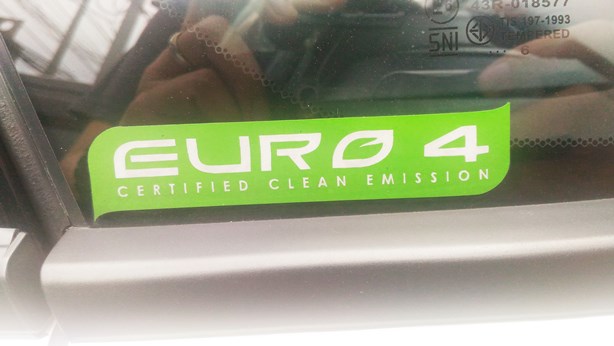
Under the hood lies the ultimate weapon of the Civic RS Turbo’s intimidation: a Euro 4-compliant 1.5L Earth Dreams Technology DOHC VTEC powerplant
Probably owing to the dimensions of the new chassis, the new Civic has a turning radius of 5.3 meters, which is considerable for a compact sedan (a bit wider than the Mitsubishi Adventure which has a turning circle of 5.2 meters); it will certainly be not so forgiving in, say, a parking lot, but it won’t matter much out in the open road. As can be expected of its lineage, the car felt agile in spite of its size, aided in part by its Vehicle Stability Assist (VSA) feature that kicks in to correct the Civic’s road manners in the event of either understeer or oversteer. A Hill Start Assist (HSA) feature helps prevent it from rolling backward during uphill starts, holding the car for just a few seconds while you step on the throttle for forward motion. At 47 liters of fuel capacity, however, one might be tempted to assume that the new Civic would not get very far compared to its rivals in the market, although on the other hand it might be an overt act of confidence on the part of Honda with regard to their much-acclaimed engine technology.
7. Honda Civic 2017 Philippines: Handling & braking
Pushing the engine switch to the right of the steering column, I heard the powerplant grumble for an instant, then peter off into a low-key growl that was almost, well, intimidating. As I was accustomed to floor-mounted handbrakes (and conventional automatics), I tried disengaging the parking brake before engaging the shifter to D. No such luck, the car wouldn’t budge. I ended up revving the engine for a few seconds before the sales agent pointed out to me that I can actually disengage the parking brake just by the throttle. Shifting to D and stepping on the gas again, I finally got the car going, careful not to engage in too much throttle input and scrape the car’s bumper (we were parked face down on a sloping sidewalk) or worse, hit incoming traffic on a busy highway.
>>> Honda Civic is listed among top 10 most reliable used vehicles under P100,000. Click to check out the full list.
8. Honda Civic 2017 Philippines: Verdict
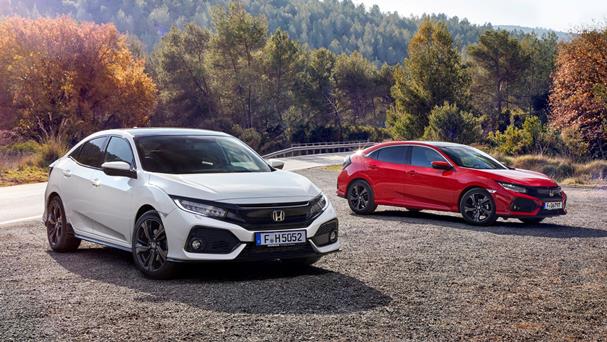
Honda’s premium pricing has always been a bone of contention between loyal fans of the brand and everyone else (myself included)
Considering everything it has to offer, one would correctly assume that the Civic RS Turbo, as with practically all Hondas, cost a pretty penny for its segment. Just how much? The 2017 Civic RS Turbo retails for ₱1,425,000, with an additional ₱20,000 premium slapped on for the White Orchid Pearl color. If you avail of Honda’s Modulo accessories package which includes various body garnishes and accessories, the price could go upwards ₱1.5M.
Honda’s premium pricing has always been a bone of contention between loyal fans of the brand and everyone else (myself included). But equally undeniable is the fact that Honda manages to justify it in a lot of respects, else there would be no explanation as to why sales, while not necessarily enough to unseat the market leader, have been brisk nonetheless. Some would argue that the lower-specced Civic 1.8E at ₱1,115,000 (without navigation) represents better value. That may be true. The very notion of a turbocharged compact sedan which will probably never get to reach cruising speed in Philippine traffic might go against our better sensibilities, but I’m still prepared to give the benefit of the doubt that the Civic RS Turbo has its market, however niche it might be, for the price it commands.
It’s not necessarily the full-on Honda experience; that belongs to the Civic Type R, featuring an even more powerful 2.0L VTEC motor and a more outlandish price tag of almost ₱3M. But they come from the same pedigree, share the same head-turning lines, and more importantly, have the same passion for driver satisfaction that will surely put a smile on whoever gets behind the wheel.
>>> Click here to read more expert reviews of most updated cars and concepts on Philkotse
Recommended articles
- Why the Mitsubishi L300 endures Sep 25, 2020
- Mitsubishi L300 August Sales Feb 24, 2022
- Mitsubishi PH lends out several L300 units to transport essential workers Oct 19, 2020
